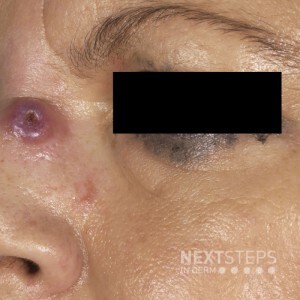
The correct answer is D. Urinary cytology.
The question is describing a patient with Muir-Torre Syndrome (photo is depicting a keratoacanthoma). These patients have autosomal dominant mutations in MSH2, MLH1, MSH6 (DNA mismatch repair genes). Dermatologically, they are at risk for sebaceous adenomas, epitheliomas, and carcinomas;keratoacanthomas (esp. w/sebaceous differentiation). These patients are also at high risk for internal malignancies, including GI, genitourinary, and breast cancers. These patients need workup with upper and lower endoscopy, genitourinary surveillance, chest xray, CBC, and liver function tests.
Kidney abnormalities are not a common feature of Muir Torre.
Thyroid abnormalities are not a common feature of Muir Torre.
PET Scan would be appropriate if initial screening shows suspicion for visceral malignancy.
Brain abnormalities are not a typical feature of Muir Torre.
Reference:Hurwitz S. Clinical Pediatric Dermatology, 2nd ed. Philadelphia: W. B. Saunders; 1990.
